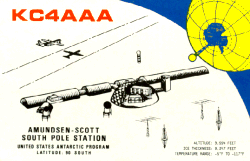![]()
|
|
|
|
|
|||
"The
North Pole is reached!" was the news that flashed all over
the world...it was September 1909 when the news reached
Amundsen. The original plan of the Fram's third
voyage--the exploration of the North Polar basin--was
quickly called off. In order to save the expedition,
Amundsen immediately turned his attention to the South
simultaneously emphasizing to his financial contributors
that the Fram's Arctic voyage would be, in every way,
a scientific expedition and would have nothing to do with
record-breaking. Therefore, as far as the supporters were
aware, Amundsen's Arctic voyage would not be influenced one
way or another by Peary's accomplishment. Since he was so heavily in debt,
Amundsen felt his change in plans to head south and capture
the South Pole should be kept a secret. In his own words,
Amundsen wrote, "I know that I have been reproached for not
having at once made the extended plan public, so that not
only my supporters, but the explorers who were preparing to
visit the same regions might have knowledge of it. I was
well aware that these reproaches would come, and had
therefore carefully weighed this side of the matter". As
hinted at, he also felt it important to keep his intentions
secret from his peers. "Nor did I feel any great scruples
with regard to the other Antarctic expeditions that were
being planned at the time. I knew I should be able to inform
Captain Scott of the extension of my plans before he left
civilization, and therefore a few months sooner or later
could be of no great importance. Scott's plan and equipment
were so widely different from my own that I regarded the
telegram that I sent him later, with the information that we
were bound for the Antarctic regions, rather as a mark of
courtesy than as a communication which might cause him to
alter his programme in the slightest degree. The British
expedition was designed entirely for scientific research.
The Pole was only a side-issue, whereas in my extended plan
it was the main object". Amundsen must have been in a dream
world as this simply was not true. Scott's intention to try
for the Pole had been widely publicised and was certainly
not a side issue...one only need turn to Scott's
Antarctic Expedition announcement in the September 13, 1909,
issue of The Times of London. Amundsen
admitted that he was heavily in debt and knew that his best
chance of raising money was to bring off a spectacular
triumph. Amundsen wrote, "If at that juncture I had made my
intention public, it would only have given occasion for a
lot of newspaper discussion, and possibly have ended in the
project being stifled at its birth. Everything had to be got
ready quietly and calmly. My brother, upon whose absolute
silence I could blindly rely, was the only person I let into
the secret of my change of plan, and he did me many
important services during the time when we alone shared the
knowledge". The only other man to know of the change in
plans was the ship's commander, Lieutenant Thorvald Nilsen.
Amundsen kept his plans so secret that only these two men,
along with Lieutenants Prestrud and Gjertsen (told on the
eve of the Fram's departure), knew of them before the
Fram reached Madeira, ostensibly on the way to Buenos
Aires and then northwards to the Arctic; the Madeira trip
was supposed to be mainly for the purpose of oceanographical
research. As they came on deck, Amundsen was
standing next to a map of Antarctica pinned to the mainmast.
Amundsen spoke, "...it is my intention to sail Southwards,
land a party on the Southern continent and try to reach the
South Pole". Gjertsen wrote, "Most stood there with mouths
agape staring at the Chief like so many question marks".
Amundsen personally asked each man if he would like to join
him on this historic journey. The last man to go ashore was
Amundsen's brother, Leon. His charge would be to mail the
men's letters and cable Scott...but not until the beginning
of October when Amundsen knew he would be beyond the point
of recall. Once Amundsen left Madeira, he
vanished, bound for an unknown destination...Scott never
dreamt it would be the Ross Sea. Scott, on board the
Terra Nova, arrived in Melbourne on the evening of
October 12, 1910. Among the mail waiting for him was
Amundsen's telegram, sent from Madeira, which came as a
complete surprise: "Beg leave inform you proceeding
Antarctic. Amundsen." Although there is no record of Scott's
reaction, Evans later recalled, "we considered that he
[Amundsen] would go to the Pole from the Weddell Sea
side". In London, Sir Clements Markham eagerly put forth his
opinion: "She [the Fram] has no more sailing
qualities than a haystack. In any case, Scott will be on the
ground and settled long before Amundsen turns up, if he ever
does". Markham gleaned information from his sources in
Norway and reported to the Royal Geographic Society's
secretary, on October 15, that Amundsen had "quietly got a
wintering hut made on board and 100 dogs and a supply of
tents and sledges. His secret design must have been nearly a
year old. They believe his mention of Punta Aranas and
Buenos Aires is merely a blind, and that he is going to
McMurdo Sound to try to cut out Scott...If I were Scott I
would not let them land, but he is always too good-natured".
Whatever the rights and wrongs of the matter, the general
view among those involved in Scott's expedition was that
Amundsen's behavior was underhanded. It took
the Fram four months to reach the Ross Ice Shelf, on
January 14, 1911. Amundsen chose the Bay of Whales as winter
headquarters for a number of reasons. First, they could sail
a whole degree farther south than Scott could hope to get in
McMurdo Sound, putting them 60 miles closer to the Pole;
secondly, they could set up their headquarters right on top
of their field of work; thirdly, animal life in the Bay of
Whales was extraordinarily rich and offered all the fresh
meat the men required in the form of seals, penguins, etc.
Besides, it offered a favorable site for an investigation of
the meteorological conditions in all directions and was very
easy to reach by ship. Unloading started on January 15 with
camp established two miles inland. The first sledge was
loaded with supplies, hitched to eight dogs and led away by
Amundsen. Fram, taken by a crewmember
aboard Terra Nova A great deal of work had to be done
over the next four months. Amundsen was well aware of
potential problems brought by nine men cramped into close
quarters over the long winter nights so a strict routine was
quickly introduced. Six days a week the men would rise at
7:30 am, have breakfast, start work at 9:00 and have lunch
at noon. They would return to their work at 2:00 pm and end
at 5:15, with the balance of the day to be used as they
pleased. Each man took his turn as the week's
housekeeper emptying ashtrays, sweeping up and generally
keeping the hut clean. Each man had two hooks on which to
hang clothes, while the rest of their small stuff was kept
out of sight in a clothes sack nearby. In addition to the
hut in which they lived, fifteen 16-man tents were erected
to store fuel and supplies. Bjaaland and Hassel built a
Scandanavian staple...a sauna. A bottomless box, on a
platform raised two feet off the ice floor, was built large
enough to slip over the man, allowing only his head to
protrude. A tin box, fitted between the platform and the ice
floor, was heated by two paraffin stoves. As the water
boiled, the compartment would fill with steam. When the man
was finished, a rope-and-pulley system would lift the box
clear, exposing a naked man, who then had to make a dash
back to the hut. Exposure to the elements would quickly seal
the pores...the event became a Saturday night
ritual. Over the
winter, every man had specific chores. Kristian Prestrud,
assisted by Hjalmar Johansen, made scientific observations;
Sverre Hassel, assisted by Helmer Hanssen, was nicknamed the
"Managing Director of Framheim's Coal, Oil and Coke Company
Limited", the position responsible for supplying lamps and
heaters with fuel. Johansen packed the sledges with
pemmican, chocolate, milk powder and biscuits. Remodelling
and overhauling of the expedition's sledging equipment was
left to the skilled carpenter, Olav Bjaaland, assisted by
Jorgen Stubberud. Bjaaland was an expert at reducing
unnecessary weight on the sledges. As well as preparing two
sets of skis for each man, Bjaaland lightened the weight of
the sledges by nearly one third. Stubberud achieved similar
results with the sledging cases. When Bjaaland was finished,
Hanssen and Oscar Wisting would assemble the sledge using
rawhide lashings. In a tiny snow cave off the main
storage room, Wisting spent most of the winter at a sewing
machine where new tents were made, complete with floors,
from weight-saving windcloth. The new tents weighed nearly
nine pounds less than the tents brought on the expedition.
The camp's cook was an overweight and jolly man named Adolf
Lindstrom. Lindstrom would rise each morning at 6:00 am to
prepare a breakfast of hot buckwheat cakes spread with
whortleberry preserve, plus wholemeal bread enriched with
wheatgerm, butter and cheese. Amundsen said Lindstroms'
cakes "slipped down with fabulous rapidity". As for lunch,
various meals were prepared from fresh or frozen seal meat,
supplemented with tinned meats by the end of winter. For
dessert, tinned California fruits, tarts, pudding, pies and
pastries, all made by Lindstrom, were served. Supper was
seal steak, bread with butter, whortleberry jam and cheese.
Coffee was the staple beverage although brandy was served on
Saturday evenings, birthdays and holidays. Amundsen made
certain the food at Framheim was very nutritious since he'd
learned first-hand the effects of scurvy while on the
Belgica Expedition in 1897. Amundsen wrote that "the going was
splendid" and they covered 31 miles over the next three
days. However, on the morning of the 11th they awoke to
frigid temperatures nearing -70°F. By the next day,
conditions were even worse as the fluid in their compasses
froze solid. Amundsen determined that it was simply too
risky to continue on towards the Pole. That evening a
decision was made to make a run for the depot, weather
permitting, unload their sledges and race back to Framheim.
The weather co-operated and they arrived at the depot on
Thursday. The next evening Hanssen and Stubberud discovered
their heels were frostbitten. As well, a number of the dogs
were suffering from the cold; two of the dogs froze to death
in their sleep. At 7:00 the next morning they set off for
Framheim. Johansen Johansen exploded, angrily accusing
Amundsen of panicking and displaying poor leadership
qualities when the group had been allowed to split up. In
the dead silence that followed, Amundsen remained
speechless. It was what Amundsen had always feared--a
confrontation with the one man in the expedition with
experience to equal his own. This brought to an end the
harmony amongst all the men as Amundsen never forgave
Johansen or spoke to him unless absolutely necessary.
Amundsen's excuse to the others was that Hanssen was
suffering too severely from frostbite to linger behind...the
men were not totally convinced. At noon,
Amundsen announced to his men a change in plans. Amundsen
would lead one party to the Pole while Prestrud--with
Johansen--would lead a second party to explore King Edward
VII Land. Amundsen's decision was not a revengeful one as he
felt that if the Pole party were not successful, at least
there might still be a "first" gained for Norway. Amundsen
then spoke to each man individually (ignoring Johansen),
asking for his pledge of loyalty...all gave it. And so, on
October 20, 1911, Amundsen, Bjaaland, Wisting, Hassel and
Hanssen departed on their historic journey to the Pole. Four
sledges were used, each pulled with 13 dogs. They made good
progress, other than a little trouble with crevasses, and
arrived at 80°S depot on the 24th. They uncovered the
provisions and gave the dogs a feast of seal meat and
blubber. The next day the party left with all
five men on skis. On the way south, they spotted a cairn
still standing as they had built it the prior April. Thus
proving reliability, another 150 similar cairns were built
on the journey south, each left with a written record inside
stating the distance and bearing to the next cairn. Each
day, as they built their cairn, lunch was eaten..."nothing
very luxurious", wrote Amundsen, "three or four dry oatmeal
biscuits, that was all. If one wanted a drink, one could mix
snow with the biscuit". They arrived at 82°S depot on
November 4. Two days later they left...they were
accomplishing 20 miles each day, in only five hours, after
which they would build their cairn, in an hour and a half,
and then rest for the remainder of the day. On November 11
the peaks of mountains were seen in the distance, which
Amundsen later named Queen Maud's Range, after the Queen of
Norway. At the foot of the range they camped
and discussed strategy for the final push to the Pole, some
340 miles distant. The final plan was to take supplies and
provisions for 30 days, along with the remaining 42 dogs,
and make the climb. After reaching the top, 24 of the dogs
would be shot, since they would no longer be needed, using
the remaining 18 in the final dash for the Pole. Once
reached, six more would be slaughtered to provide food for
the remaining twelve on the trip back to Framheim. On
November 17 they started the climb up the Axel Heiberg
Glacier. The weather was warm and the climb even better as
they covered 11.5 miles before making camp at 2000 feet.
Four days later, on November 21, they found themselves at
the summit. They'd managed to carry a ton of supplies to an
altitude of 10,000 feet. Twenty-four dogs were shot and the
party stayed at "The Butcher's Shop", as it was now called,
for four more days before heading off into a raging
blizzard. They had already waited two days longer than
planned so they had no choice but to push on. For the next
ten days they struggled, five men and 18 dogs, against
driving snow in 35 mph winds and thick fog. At last they
reached the plateau, only to be confronted by "The Devil's
Ballroom", a glacier with a thin crust of snow covering a
number of dangerous, deep crevasses. This proved to be the
last major obstacle. There were festivities in the tent
that evening with each man sharing a little seal meat. At
midnight observations were taken that put them at 89°
56'S. Arrangements were now made to encircle the camp with a
radius of approximately twelve and a half miles. At noon, on
December 17, the observations had been completed and it was
certain the men had done all that could be done. In order to
come a few inches closer to the actual Pole, Hanssen and
Bjaaland went out four geographical miles and promptly
returned. Bjaaland surprised Amundsen when he pulled out a
cigar-case full of cigars at dinner. A cigar at the Pole!
Following the festival dinner, preparations for departure
began. A tent was erected, naming it Poleheim, with Amundsen
leaving a message inside for Scott, along with a letter for
King Haakon. Thirty-nine days later the party returned to
Framheim, as planned, with all five men and 11 dogs "hale
and hearty". The month-long voyage back to Tasmania was a
frustrating time for Amundsen, who was now quite anxious to
be the first to announce the news of their achievement. On
March 7, 1912, Amundsen finally cabled his brother Leon with
the historic news. During
World War I Amundsen made a significant amount of money from
supplying "neutral" shipping. He went on to build the
Maud in order to continue his Arctic drift. He
managed to complete the Northwest Passage around
Siberia--only the second to do so--but failed in his attempt
to proceed farther north. Subsequently, he left the ship in
1921. Amundsen now became consumed with flying, but was soon
facing extreme financial hardship before gaining support
from Lincoln Ellsworth. Together with Ellsworth, history was
made when they flew the airship Norge from
Spitsbergen to Alaska via the North Pole. This was the first
trans-Arctic flight right across the Pole. Amundsen,
fulfilled by his reputation, now retired. Unfortunately, he
never could come to terms with the British reaction to his
secret change of plans in 1910. Mill, of the Royal
Geographic Society, described him as the most unhappy of all
the polar explorers he had ever met. In 1928, while
searching for survivors of an airship disaster, Amundsen's
plane crashed and he disappeared without a trace.
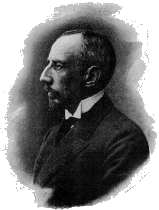 Roald
Amundsen, born in 1872 near Oslo, Norway, left his mark on
the Heroic Era as one of the most successful polar explorers
ever born. His career of adventure began at the age of 15,
originally studying medicine, but dropping out to go to sea
where he soon moved his way up to the rank of mate. His
first experience in the Antarctic was with Adrien
de Gerlache's 1899
Belgica Expedition. He became the first to travel the
Northwest Passage, in his ship Gjoa in 1903-06. After
this expedition, plans were assembled to drift across the
North Pole in Nansen's famous Fram, but news arrived
of Peary's successful attainment of the pole which caused
Amundsen to make new plans--covert plans--for an
expedition to the Antarctic and the subsequent capture of
the South Pole. On December 14, 1911, Amundsen and four
others stood at the South Pole, a month before
Robert
Scott. This expedition was an
incredible masterpiece of organization. Here is the
story...
Roald
Amundsen, born in 1872 near Oslo, Norway, left his mark on
the Heroic Era as one of the most successful polar explorers
ever born. His career of adventure began at the age of 15,
originally studying medicine, but dropping out to go to sea
where he soon moved his way up to the rank of mate. His
first experience in the Antarctic was with Adrien
de Gerlache's 1899
Belgica Expedition. He became the first to travel the
Northwest Passage, in his ship Gjoa in 1903-06. After
this expedition, plans were assembled to drift across the
North Pole in Nansen's famous Fram, but news arrived
of Peary's successful attainment of the pole which caused
Amundsen to make new plans--covert plans--for an
expedition to the Antarctic and the subsequent capture of
the South Pole. On December 14, 1911, Amundsen and four
others stood at the South Pole, a month before
Robert
Scott. This expedition was an
incredible masterpiece of organization. Here is the
story...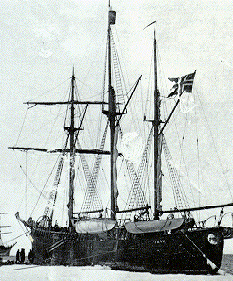 The
Norwegians left Christiania on August 9, 1910, eight weeks
after Scott's Terra Nova Expedition had departed
Cardiff. On board were 97 Greenland dogs, the key to
Amundsen's success, along with a hut and provisions for two
years in the Antarctic. A month later, on September 6, the
Fram arrived at Madeira where fresh water and other
provisions were taken on board. A few minor repairs were
made to the ship as the crew enjoyed some free time ashore.
On the evening of the 9th, some three hours before departing
for Antarctica, Amundsen called the crew to his attention.
Many of the men were quite puzzled and unhappy to be
interrupted as they were quickly writing final letters for
home.
The
Norwegians left Christiania on August 9, 1910, eight weeks
after Scott's Terra Nova Expedition had departed
Cardiff. On board were 97 Greenland dogs, the key to
Amundsen's success, along with a hut and provisions for two
years in the Antarctic. A month later, on September 6, the
Fram arrived at Madeira where fresh water and other
provisions were taken on board. A few minor repairs were
made to the ship as the crew enjoyed some free time ashore.
On the evening of the 9th, some three hours before departing
for Antarctica, Amundsen called the crew to his attention.
Many of the men were quite puzzled and unhappy to be
interrupted as they were quickly writing final letters for
home.

For the
next three weeks, five sledges, 46 dogs and five men
transferred some 10 tons of supplies daily to base camp.
Meanwhile, the carpenter, Jorgen Stubberud, supervised the
assembly of the prefabricated hut. After a visit from
Scott's Terra Nova, the base camp was christened
Framheim--"The home of Fram"--and the depot-laying journeys
began. Within a three-week period, depots were established
at 80°S, 81°S and 82°S...more than a ton and
a half of supplies had been stored within 480 miles of the
Pole. On April 21 the sun finally sank and the long winter
night began.
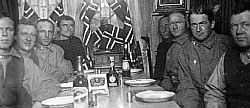 The
men actually enjoyed getting together each evening over
supper. Since they had worked in different parts of the camp
during the day, rarely was there a lack of conversation come
evening time. Card games, dart matches, reading and
needlework took place often around the main table.
Occasionally the gramophone was brought out and a few
records played. But, despite the relative easy passing of
winter nights, Amundsen remained worried about Johansen's
quick temper. Forced abstinence from alcohol made Johansen
quite difficult to deal with at times. To make matters
worse, Johansen had as much experience in polar exploration
as Amundsen; he had been to the Arctic with Nansen. Johansen
felt this put him, at worst, on level par with Amundsen. And
then there was the matter of Robert Scott...how far had the
English advanced? Amundsen was aware that Scott was using
motorized sledges although he doubted their efficiency.
Little did he know of what was going on at McMurdo
Sound.
The
men actually enjoyed getting together each evening over
supper. Since they had worked in different parts of the camp
during the day, rarely was there a lack of conversation come
evening time. Card games, dart matches, reading and
needlework took place often around the main table.
Occasionally the gramophone was brought out and a few
records played. But, despite the relative easy passing of
winter nights, Amundsen remained worried about Johansen's
quick temper. Forced abstinence from alcohol made Johansen
quite difficult to deal with at times. To make matters
worse, Johansen had as much experience in polar exploration
as Amundsen; he had been to the Arctic with Nansen. Johansen
felt this put him, at worst, on level par with Amundsen. And
then there was the matter of Robert Scott...how far had the
English advanced? Amundsen was aware that Scott was using
motorized sledges although he doubted their efficiency.
Little did he know of what was going on at McMurdo
Sound.
Fridtjof
Nansen 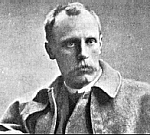
By August
24 the sun had reappeared and the packed sledges were ready
to be taken out from their underground storage. But two
long, frustrating months would pass before the weather was
warm enough for them to start the journey to the Pole.
Tensions increased as each day passed. Amundsen would have
the men and dogs prepared for departure only to cancel at
the last moment due to inclement weather. The weather had to
be clear for their first run to the 80°S depot, or
there was a real risk of missing it. Finally, on Friday,
September 8, 1911, they sped off across the snow...eight men
with sledges pulled by 86 dogs; only Lindstrom was left
behind as custodian of Framheim.
 They
would normally keep in sight of each other but the first two
sledges moved so rapidly that the others were soon left
behind. The sledge teams continued to break up, with
Bjaaland and Stubberud reaching Framheim first at 6 pm,
followed two hours later by Amundsen's group. A half an hour
after that Hassel arrived and six hours later, at 12:30 am,
Johansen and Prestrud finally stumbled into camp. Johansen
and Prestrud were totally exhausted, having found Framheim
in the dark and fog only by following the barking of the
dogs. At breakfast the next morning, Amundsen finally
succeeded in knocking the chip off Johansen's shoulder when
Amundsen asked why it had taken them so long to make it back
to Framheim.
They
would normally keep in sight of each other but the first two
sledges moved so rapidly that the others were soon left
behind. The sledge teams continued to break up, with
Bjaaland and Stubberud reaching Framheim first at 6 pm,
followed two hours later by Amundsen's group. A half an hour
after that Hassel arrived and six hours later, at 12:30 am,
Johansen and Prestrud finally stumbled into camp. Johansen
and Prestrud were totally exhausted, having found Framheim
in the dark and fog only by following the barking of the
dogs. At breakfast the next morning, Amundsen finally
succeeded in knocking the chip off Johansen's shoulder when
Amundsen asked why it had taken them so long to make it back
to Framheim. 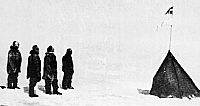 On
December 8, with the sun shining brightly, they passed
Shackleton's
farthest south, 88°23'S. They were only 95 miles from
the South Pole. The dogs were hungry and exhausted, the men
had many sores and frostbitten faces, yet still the party
pushed on. The closer they came to the Pole, the more
Amundsen worried that Scott had already beaten them. The
temptation to race on, at full speed, was shared by
everyone. At 3:00 pm, on Friday, December 14, 1911, there
was a simultaneous cry of "Halt!" as the sledge meters
registered their arrival at the South Pole. They had
achieved their goal. Symbolic of their struggle in unity,
each of the men, with their weathered and frostbitten hands,
grasped the Norwegian flag and planted it firmly at the
geographical South Pole. Amundsen named the plain King
Haakon VII's Plateau.
On
December 8, with the sun shining brightly, they passed
Shackleton's
farthest south, 88°23'S. They were only 95 miles from
the South Pole. The dogs were hungry and exhausted, the men
had many sores and frostbitten faces, yet still the party
pushed on. The closer they came to the Pole, the more
Amundsen worried that Scott had already beaten them. The
temptation to race on, at full speed, was shared by
everyone. At 3:00 pm, on Friday, December 14, 1911, there
was a simultaneous cry of "Halt!" as the sledge meters
registered their arrival at the South Pole. They had
achieved their goal. Symbolic of their struggle in unity,
each of the men, with their weathered and frostbitten hands,
grasped the Norwegian flag and planted it firmly at the
geographical South Pole. Amundsen named the plain King
Haakon VII's Plateau.
